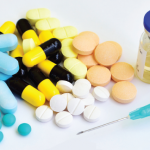Guidelines
For additional information, the American Academy of Dermatology (AAD) and the National Psoriasis Foundation (NPF) have updated psoriasis treatment guidelines. Their first joint guideline is for managing and treating psoriasis with biologics. It can be reviewed here.1 The AAD/NPF team has also published a second guideline on treating psoriasis with awareness and attention to comorbidities.7
The new psoriasis guidelines arrive on the heels of the new PsA treatment guideline, which was discussed in Part 1 of this series.8 These new guidelines mark a new era in the treatment of psoriatic disease.
Apremilast (Otezla):9 tablets
Drug class: DMARD, phosphodiesterase 4 (PDE4) inhibitor
Warnings & Precautions
- Depression: Individuals should be alerted to watch for the emergence or worsening of depression, suicidal thoughts or other mood changes. If these changes occur, they should contact their physician. Carefully weigh the risks and
benefits of apremilast treatment in patients with a history of depression and/or suicidal thoughts or behavior. - Weight decrease: Weight should be regularly monitored. If unexplained or clinically significant weight loss occurs, consider discontinuing apremilast.
- Drug interactions: Using apremilast with strong cytochrome P450 (CYP 450) enzyme inducers (e.g., rifampin, phenobarbital, carbamazepine, phenytoin) is not recommended due to potential loss of efficacy.
Dosage & Administration
To reduce the risk of gastrointestinal symptoms, titrate to 30 mg twice daily according to the following schedule:
- Day 1: 10 mg in the morning
- Day 2: 10 mg in the morning and 10 mg in the evening
- Day 3: 10 mg in morning and 20 mg in the evening
- Day 4: 20 mg in the morning and 20 mg in the evening
- Day 5: 20 mg in the morning and 30 mg in the evening
- Day 6 and thereafter: 30 mg twice daily
Dosage in severe renal impairment: 30 mg once daily. For initial dosage titration: Titrate using the morning schedule listed above and skip the afternoon dose.
Commentary: The safety and effectiveness of apremilast were evaluated in two multicenter clinical trials, which enrolled a total of 1,257 patients. Patients treated with the drug experienced significant, clinical improvement in plaque psoriasis at Week 16 of the studies as measured by the Psoriasis Area and Severity Index (PASI 75) score. The most common adverse reactions (≥5%) are diarrhea, nausea and headache.
*Important Safety Information (ISI)
This ISI is applicable to all tumor necrosis factor inhibitors (TNFi’s) and some other immune modulators.
Serious Infections & Malignancies
- There is an increased risk of serious infections leading to hospitalization or death, including tuberculosis (TB), bacterial sepsis, invasive fungal infections (e.g., histoplasmosis) and infections due to other opportunistic pathogens. If these develop, discontinue the drug.
- Patients should be tested for latent TB prior to starting the drug and during therapy. Treatment for latent TB should be initiated prior to starting the drug. Patients, including those who tested negative for latent TB infection prior to initiating therapy, should be closely monitored for the development of signs and symptoms of infection during and after treatment with the drug. Induration of 5 mm or greater with tuberculin skin testing should be considered a positive test result when assessing if treatment for latent tuberculosis is needed prior to initiating the drug, even for patients previously vaccinated with Bacile Calmette-Guerin (BCG).
- Lymphoma and other malignancies, some fatal, have been reported in children and adolescents treated with TNFi’s.
Adalimumab (Humira):10 injection
Biosimilars: Adalimumab-atto (Amjevita),11 Adalimumab-adbm (Cyltezo),12 Adalimumab-adaz (Hyrimoz)13
Drug class: DMARD, TNFi
Boxed warning: Refer to *ISI (above) and



